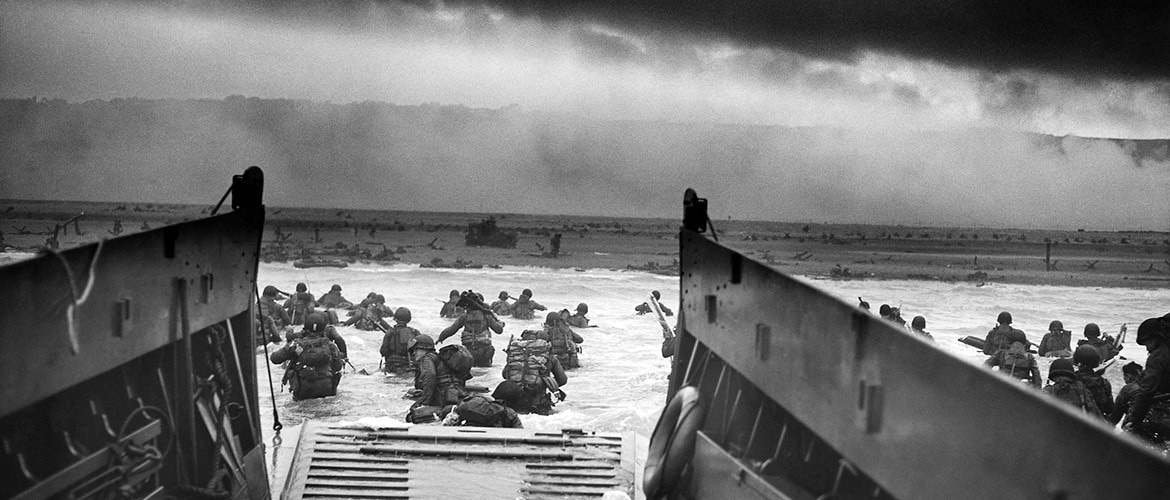
Landing craft delivering troops to Omaha Beach during D-Day in World War II.
On June 6, 1944, Allied forces landed in German-occupied France in the largest amphibious invasion in history. D-Day was only the beginning of the larger Normandy Campaign, which lasted through the end of August and included more than 2 million soldiers. Their efforts during those three months assured Allied victory over Nazi Germany in Europe.
More than 75 years later we listen to their stories and remember their efforts.
Oral histories recorded for Atlanta History Center’s Veterans History Project.
“I was sitting facing the door…And I was looking right directly at one of the planes as it was hit, and it blew up in just a ball of fire…It’s probably the most scared I’ve ever been in my life. I think they’ll all agree to that. You know…big brave paratrooper…you hate to say you were scared, but we were scared.”
Robert Leslie Williams, United States Army, 101st Airborne Division,506th Parachute Infantry Regiment, 2nd Battalion
Bob Williams was 18 years old when he enlisted in the U.S. Army in the summer of 1942. Like many thousands of boys across America, he couldn’t bear to be “left behind” in the war effort. An “Uncle Sam Wants You” poster on a post office window beckoned him and the sight of a paratrooper—then a new type of infantry soldier—with a Thompson submachine gun convinced him that he wanted to be one.
Less than two years later, he found himself in one of hundreds of C-47 troop transport planes flying just a few hundred feet over the hedgerows of Normandy, dodging horrific enemy fire while taking part in the largest amphibious invasion in history.
C-47As of the 88th TCS towing gliders over Normandy in June 1944.
Flying in another troop transport plane that night was Atlantan Wright Bryan. A managing editor of the Atlanta Journal, Bryan had the scoop of a lifetime when he was allowed to fly with the 101st Airborne Division into Normandy on the night of June 5, 1944. As their plane headed across the English Channel, Bryan watched the commanding officer of the paratroopers move among his men, asking if they had everything they needed.
Private Robert C. Hillman of Manchester, Connecticut, piped up, “I know my chute’s okay because my mother checked it,” he said. “She works in the Pioneer Parachute Company in our town. And her job is giving the final ‘once-over’ to all chutes they manufacture.” In one of the war’s incredible coincidences, Private Hillman’s parachute was indeed marked with his mother’s initials. Bryan’s report, filed after his return to London, provided the world with the first eyewitness account of the invasion, and the assurance that Mrs. Hillman’s war industry work had paid a very personal dividend.
Much has been written about D-Day in the 75 years since June 6, 1944. Almost nothing went right from the very start. Airborne troopers were scattered miles away from each other and from their intended drop zones due to bad weather, enemy fire, and inexperienced pilots. Aerial bombardment, designed to destroy or at least diminish German defenses, failed to significantly affect them. Anyone who has seen Steven Spielberg’s 1998 film, Saving Private Ryan, will not forget his graphic representation of the chaos and horror faced by infantry troops and Navy coxswains at Omaha Beach.
Reconnaissance photo of Point du Hoc, 1944.
Despite the things that went wrong, there were men who pushed forward. Herman Stein, an Army Ranger who scaled the cliffs at Point du Hoc, remembers losing his buddy, the BAR (Browning Automatic Rifle) man, “I said, ‘Geez, you’d better get down, Rich, there might be a sniper around.’ I no sooner said that, then bingo, right through the throat he got it…So I’m holding…a flap of skin over it and trying to stop the blood, you know. I seen his eyes open. I knew he was dead, you know. So I figured, well, all I can do is take the gun [and fight the enemy]…”
And he did. And they did. They gathered the scattered remnants of their platoons. They carried their wounded and dead to safety. They improvised, and they engaged the enemy with skill and bravery.
They continued to do so until Normandy was free.
My own uncle, Lieutenant Sidney Francis Atkins Jr., was in the 101st Airborne and participated in the D-Day invasion. I was fortunate to visit Normandy in 2014 to retrace his footsteps. It was the 70th anniversary of the D-Day invasion and American flags fluttered from windows and flower boxes in every little village. It felt like the importance of America was everywhere in Normandy. In Colleville-sur-Mer, site of a temporary American cemetery established two days after the invasion, the buildings were covered with life-sized photographs of the village as it looked in June 1944.
Colleville-sur-Mer, France, during 70th anniversary of D-Day.
The people of Normandy have not forgotten America and what the Allies did for them.
That temporary American cemetery later became the Normandy American Cemetery and Memorial. The sight of thousands of white crosses sweeping across the fields to the bluffs that border Omaha Beach is an image that will stay with me forever.
But D-Day, a critically important part of a critically important campaign, was not the end of the war. Eleven more months of bloody combat followed Allied success in Normandy before Germany surrendered, May 7, 1945. That was followed by three more bloody months before the Japanese surrender.
Neither event came soon enough for my uncle. While supervising a training exercise in France, an 81mm mortar shell killed him. The shell was fired by a fellow American soldier and fell short of its target. He was killed instantly, 47 days before the end of the war in Europe.
At the conclusion of Bob Williams’ interview, the interviewer asks if he has any final remarks. Williams responds, “If you want to remain free, you’ve got to pay the price, no matter what it costs.”
16 million American men and women paid that price. 416,800 paid it with their lives.
Less than one-half million World War II veterans are alive today. According to the Veterans Administration, we lose another 348 World War II veterans every single day. The time is not too far distant when no eyewitnesses remain.
We owe it to them all to collect, preserve, and share their stories. Honor them. Share your story with Atlanta History Center’s Veterans History Project.
Sue VerHoef is Atlanta History Center’s Director of Oral History and Genealogy. Sue is one of our most passionate colleagues, particularly when it comes to preserving the stories of veterans. Her work with our Veterans History Project ensures that future generations will better appreciate the realities of war and the sacrifices of those who serve in uniform.
